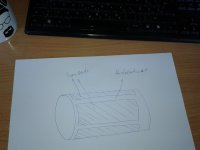You are absolutely right, it was just fishing in muddy waters. All I can say from the numbers is this driver has better capabilities to move and control the cone at lower excursion.
So I was hoping to buy the exact driver which was used in the Genelec S360A with the PHL 3411, but it does not look identical. The texture of the diaphragm is slightly more patterned and its color is grey rather than black. This is a disappointment as I was hoping to be able to count on the choices done at Genelec.
Genelec S360A

PHL 3411-8

Genelec S360A
PHL 3411-8
They look more similar than different, and drivers can look quite different under different angles and lights. The PHL 3411 has some really nice Klippel results in the datasheet. It looks ideal for loud but not really for deep bass.So I was hoping to buy the exact driver which was used in the Genelec S360A with the PHL 3411, but it does not look identical. The texture of the diaphragm is slightly more patterned and its color is grey rather than black. This is a disappointment as I was hoping to be able to count on the choices done at Genelec.
The bass was supposed to be equalized as in the model, Genelec S360A.
Maybe there are different versions of the appearance? https://www.phd-audio.fr/principale-v3-evo1.html
The thing is simply that I was confident if Genelec decided this driver was their best choice, I could stop with the brooding whether or not the driver would perform in a two-way application: playing both mids as well as bass.
Maybe there are different versions of the appearance? https://www.phd-audio.fr/principale-v3-evo1.html
The thing is simply that I was confident if Genelec decided this driver was their best choice, I could stop with the brooding whether or not the driver would perform in a two-way application: playing both mids as well as bass.
It is no doubt a slightly different OEM spec driver. I can't see it being different enough to be a deal breaker. There are very few 10" woofers from Pro manufacturers, the 3411 looks better than the others to me.
This photo from that PHD site looks more like the Genelec version too

This photo from that PHD site looks more like the Genelec version too
So one could reason the difference lies in the appearance: For end users, the black & grey color scheme, while manufacturers get a more nice, all black finish with tacit concentric rings. To bad, but not a deal breaker as you put it. At least, the PHD site gives evidence that they use a designation 3411 driver which looks as the one in Genelec S360A, and this is the same designation as with those sold at TLHP. Now one must hope that specs are very close ..
No company at the level of Genelec will want to make it easy for anyone else to copy their products, so they will almost certainly specify some changes to make their drivers unique compared to the stock versions. It could be as simple as a different colour yes, but our best approach is always to assume we can optimise the performance of the drivers available (with enough knowledge and experience of course), and not to clone a commercial product exactly.
For me it was mostly the question if the driver specs are identical. The looks of the OEM is more appealing to the eye, but this is nothing bothering. It could well be the case that both drivers are technically almost identical.
1) I have material for another chipboard test box, to check if the driver PHL 3411 works in the intended enclosure size and tuning. Planned outer dimensions are 57 × 32 × 27 cm. I was thinking to do it this weekend, but the weather is nice and the city streets inviting. I will get the baffle CNCed, I have decided.
2) Next is to get the waveguide printed. After @TNT had such good experiences with JLCPCB, I will also have it done there. After last simulation run, I am undecided if I can or want to try to improve on it. It could be possible, but it takes a long time to calculate full enclosure. The issue is a slight waste-banding around 1.5k and a widening around 1.8k, which are still a thorn in my eye, and which is not easily solved, if at all. The reason is that a upper vertical diffraction which has its source around 500 Hz is accentuating the unenveness
Hor, Ver Up:
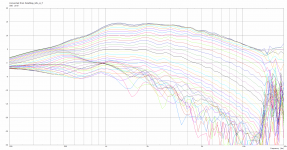
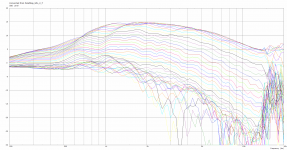
DI for all axis, Hor, Ver
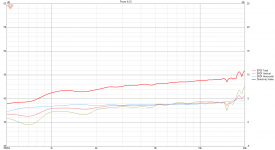
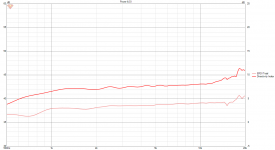
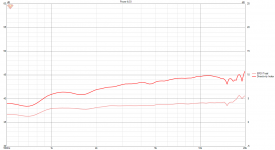
I want to check if in quarter symmetry it can be optimized. However, one could also live with it??
The currently best summing crossover is a LR24 on the compression driver at 1.1k, which I cannot do with the Celestion driver, and BW18 at 1.3k on the woofer. Crossover frequency is around 1420 Hz. The second best which on listening axis down to-10 deg has subpar summation but otherwise is good is LR24 at 1.25k and BW18 at 1.35k, which can be attained with CDX1-1747. Crossover frequency here is around 1480 Hz.
1.1/1.3:
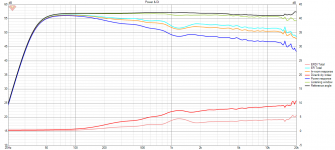
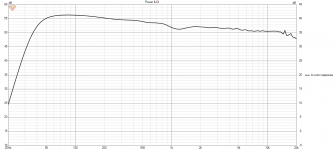
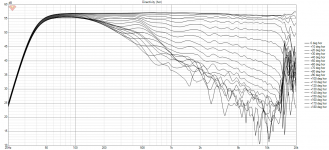
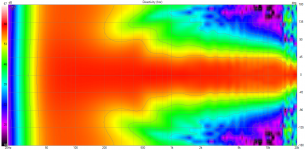
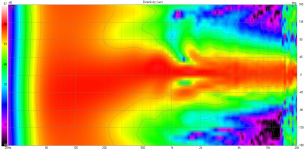
1.25/1.35

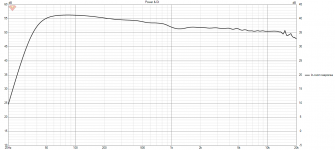
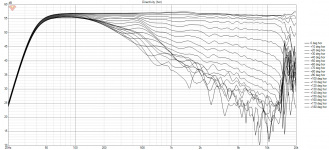

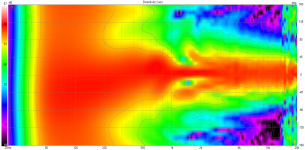
Yes, it's maybe a bit obsessed, but if I could improve it before creating the WG, I would. So I have been optimizing ideal data.
2) Next is to get the waveguide printed. After @TNT had such good experiences with JLCPCB, I will also have it done there. After last simulation run, I am undecided if I can or want to try to improve on it. It could be possible, but it takes a long time to calculate full enclosure. The issue is a slight waste-banding around 1.5k and a widening around 1.8k, which are still a thorn in my eye, and which is not easily solved, if at all. The reason is that a upper vertical diffraction which has its source around 500 Hz is accentuating the unenveness
Hor, Ver Up:


DI for all axis, Hor, Ver



I want to check if in quarter symmetry it can be optimized. However, one could also live with it??
The currently best summing crossover is a LR24 on the compression driver at 1.1k, which I cannot do with the Celestion driver, and BW18 at 1.3k on the woofer. Crossover frequency is around 1420 Hz. The second best which on listening axis down to-10 deg has subpar summation but otherwise is good is LR24 at 1.25k and BW18 at 1.35k, which can be attained with CDX1-1747. Crossover frequency here is around 1480 Hz.
1.1/1.3:





1.25/1.35





Yes, it's maybe a bit obsessed, but if I could improve it before creating the WG, I would. So I have been optimizing ideal data.
So I made another test box. The dip at 700 is an artifact, not really there.
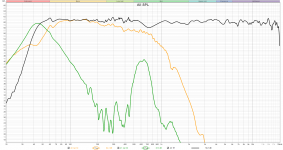
The PHL 3411 behaves very different from the Faital 12PR320. With the Faital, I had a bass shelf of +7 dB and still was missing some punch. The opposite with the PHL: I wanted to apply more room EQ than HPX allows me (currently I cannot go lower than -15,9 dB, Q=7 at 50 Hz), but I need to investigate how I can make it flat to 20 Hz.
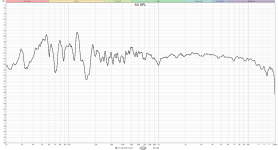
(The spike at 120 Hz is not there either, some variation with MMM measurements, but the through at 160 Hz is existing very much)
What can I say? First, I thought the PHL 3411 is dull in voices. But this was also me preasumed fear and I have learned a big deal about linear distortion, how seemingly small deviations and ratios change the whole presentation. It is very much correct that linear distortion is hold as the most relevant in empirical research of speaker preference. Ever, if a certain frequency band is dominating, one can easily misunderstand the speaker. In this case the PHL 3411 gave room for voices (the "holy mid-range"), when the bass was removed agressive with room EQ. It is now much more open, but still a bit darker than the Faital.
I still am undecided if the Faital, whose cone is light weight as a feather (the fingers can feel it, too), compared to the PHL, whose cone is heavily treated (no flex at all), gives more vivid voices. Could be. But I must first learn more about FR of the new driver. On the other hand: When the Faital was not EQ-ed for the room, its bass was blurish. In case of the PHL, it was very heavy instead. And this is definitely where the latter seems to hold an advantage: this driver defines bass with weight, even when the bass is trimmed down. The Faital however was always a bit ephemeral. In a sweet way, but also leaving some wishes unfulfilled. And even when bass was admitted, it was rather voluminous than possesing weight.
However, I am leaning myself far out the window. I spend the day to insulate the side and back wall with a triple layer of heavy fleece material to get the port resonance controlled, which was only partly succesful, as you can see. After that I spend the rest of the day to create the filter function and then, room EQ. There is much more to find out. Maybe the port position must be changed. It does only slightly influence the anechoich frequency response, because the port is rear facing, but then shows up again in inroom measurements.

The PHL 3411 behaves very different from the Faital 12PR320. With the Faital, I had a bass shelf of +7 dB and still was missing some punch. The opposite with the PHL: I wanted to apply more room EQ than HPX allows me (currently I cannot go lower than -15,9 dB, Q=7 at 50 Hz), but I need to investigate how I can make it flat to 20 Hz.

(The spike at 120 Hz is not there either, some variation with MMM measurements, but the through at 160 Hz is existing very much)
What can I say? First, I thought the PHL 3411 is dull in voices. But this was also me preasumed fear and I have learned a big deal about linear distortion, how seemingly small deviations and ratios change the whole presentation. It is very much correct that linear distortion is hold as the most relevant in empirical research of speaker preference. Ever, if a certain frequency band is dominating, one can easily misunderstand the speaker. In this case the PHL 3411 gave room for voices (the "holy mid-range"), when the bass was removed agressive with room EQ. It is now much more open, but still a bit darker than the Faital.
I still am undecided if the Faital, whose cone is light weight as a feather (the fingers can feel it, too), compared to the PHL, whose cone is heavily treated (no flex at all), gives more vivid voices. Could be. But I must first learn more about FR of the new driver. On the other hand: When the Faital was not EQ-ed for the room, its bass was blurish. In case of the PHL, it was very heavy instead. And this is definitely where the latter seems to hold an advantage: this driver defines bass with weight, even when the bass is trimmed down. The Faital however was always a bit ephemeral. In a sweet way, but also leaving some wishes unfulfilled. And even when bass was admitted, it was rather voluminous than possesing weight.
However, I am leaning myself far out the window. I spend the day to insulate the side and back wall with a triple layer of heavy fleece material to get the port resonance controlled, which was only partly succesful, as you can see. After that I spend the rest of the day to create the filter function and then, room EQ. There is much more to find out. Maybe the port position must be changed. It does only slightly influence the anechoich frequency response, because the port is rear facing, but then shows up again in inroom measurements.
Last edited:
....
However, I am leaning myself far out the window. I spend the day to insulate the side and back wall with a triple layer of heavy fleece material to get the port resonance controlled, which was only partly succesful, as you can see. After that I spend the rest of the day to create the filter function and then, room EQ. There is much more to find out. Maybe the port position must be changed. It does only slightly influence the anechoich frequency response, because the port is rear facing, but then shows up again in inroom measurements.
Use some wadding material (or whatever material you are using for damping), make a bung out of it and position it in front of port with few centimeters to spare. Like this:
https://www.audiosciencereview.com/...ies-dual-concentric.29383/page-3#post-1025993
If it isn't standing wave port leagake, you could make a test port out of PVC pipe.It could be done with classic BR tube by cutting windows at the flat part of BR pipe and gluing flexible material that will not leak air. Stuff Kef used is very similar to foam mouse pads only a bit thinner. As per their white paper and measurements, it absorbs part of the energy so resonance will be much lower in level. Hard plastic parts are there just for reinforcement so that port wouldn't change its length as the pressure builds up. Sketch up power - go 🙂
Attachments
I already noted that with the Faitals, I had chosen to set BSC only to 4 dB compensation. Because of the massive brick wall gain in my room. But one may never forget, I mean one must learn, that bass by room gain and speaker bass does sound different. Here I remember when Erin complained about the, in his experience, lean bass of KEF speakers, which have this inbuilt room compensation, a bass shelf to be filled by room gain for flat in-room response. Naturally, even after heavy combating of room modes, the PHL play darker when BSC is set to 6 dB. This is actually required to reach the anechoic flat response that I showed above.
Try to make such amount of BSC to get either flat or slightly downward tilted (1dB max) sound power response 150Hz and bellow. In your simulation i see that your sound power is tilted upwards toward low frequencies.
Port may also influence mids, making them blurry. Try to get rid of that port resonance to exclude port sound from midrange frequencies.
Oh, and i tottaly agree about lows from the room and from the driver itself. You're getting dB's in frequency domain but not a lot of detail retrieval. That could also be because of lack of room treatment at those frequencies. All things to consider.
Port may also influence mids, making them blurry. Try to get rid of that port resonance to exclude port sound from midrange frequencies.
Oh, and i tottaly agree about lows from the room and from the driver itself. You're getting dB's in frequency domain but not a lot of detail retrieval. That could also be because of lack of room treatment at those frequencies. All things to consider.
Last edited:
A size comparison:
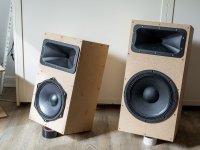
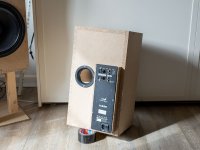
After I had tuned the bass more according to the Faital, it ... sounded much more like it. The airiness is almost their. This linear distortion thing, it is so powerful. Must investigate further, though. What can be said however: appart from the lesser directivity advantage in low frequencies one trades in with the 10 inch woofer, I think this smaller box is just as capable as the big one.


After I had tuned the bass more according to the Faital, it ... sounded much more like it. The airiness is almost their. This linear distortion thing, it is so powerful. Must investigate further, though. What can be said however: appart from the lesser directivity advantage in low frequencies one trades in with the 10 inch woofer, I think this smaller box is just as capable as the big one.
If smaller form factor is what you were after, when i look at your pic, it doesn't seem worth additional expense in money and time - in my opinion. Unless you have some room constraint with fixed size for a loudspeaker width/depth, you could've easily continued listening to slightly larger Faital.
If building, measuring and listening to differences is what drives you, that i understand quite well.
If building, measuring and listening to differences is what drives you, that i understand quite well.
Yes, our city apartment is not big at all, it makes a noticeable difference in the living room. Money and time where spent to explore what is a solution I find just right. Maybe I will build a big set with the Faitals and a free standing waveguide sometime later, for the studio or so. The ten-inch form factor is the compromise I was searching for. Also, spending day after day with ath is probably not worth the outcome, in relative terms, it’s just a game to me.
The new version is 70 percent of the size, or a 30 percent size reduction.
0,049 versus 0,070 cubic meters (external).
The new version is 70 percent of the size, or a 30 percent size reduction.
0,049 versus 0,070 cubic meters (external).
Last edited:
- Home
- Loudspeakers
- Multi-Way
- Driver for JBL 708-ish dimensioned 2-way
